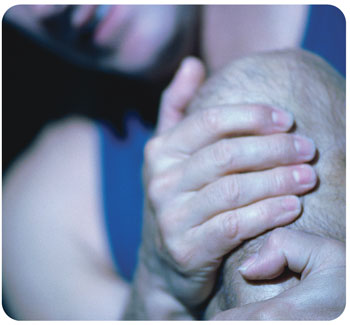 Osteoarthritis is the most common form of knee arthritis. Arthritis is usually a slowly progressive degenerative disease in which the joint cartilage gradually wears away, much like the tread on a tire. Once that cartilage is worn away, it cannot regenerate. It most often affects middle-aged and older people.
Osteoarthritis is the most common form of knee arthritis. Arthritis is usually a slowly progressive degenerative disease in which the joint cartilage gradually wears away, much like the tread on a tire. Once that cartilage is worn away, it cannot regenerate. It most often affects middle-aged and older people.
Generally, the pain associated with arthritis develops gradually, although sudden onset is also possible. The joint may become stiff and swollen, making it difficult to bend or straighten the knee.
Your Orthopedic Surgeon will perform a physical examination that focuses on your walk, the range of motion in the limb, and joint swelling or tenderness. X-rays typically show a loss of joint space and bone spurs in the affected knee.
In its early stages, arthritis of the knee is treated with nonsurgical measures. Lifestyle modifications can include losing weight, switching from running or jumping exercises to swimming or cycling, and minimizing activities that aggravate the condition, such as climbing stairs. Exercises can help increase range of motion and flexibility as well as help strengthen the muscles in the leg. Physical therapy and exercise are often effective in reducing pain and improving function. Using supportive devices, such as a cane, wearing energy-absorbing shoes or inserts, or wearing a brace or knee sleeve can be helpful.
Several types of medications can be used in treating arthritis of the knee. Because every patient is different, and because not all people respond the same to medications, your doctor will develop a program for your specific condition. Over the counter anti-inflammatory medications are usually the first choice of doctors and can include aspirin, acetaminophen, naproxen or ibuprofen to help reduce swelling and pain in the joint. Stronger, prescription strength anti-inflammatories such as Celebrex, meloxicam and etodolac can be used too.
Corticosteroids are powerful anti-inflammatory agents that can be injected into the joint. They are given for moderate to severe pain. However, the effects are not long-lasting, and no more than four cortisone injections should be given per joint per year. Viscosupplementation involves injecting gel-like substances into the joint to improve the quality of the joint fluid. Some common names of these types injections are Synvisc or Orthovisc. These injections can allow the moving parts of the knee to move more smoothly, much like putting oil in your car engine.
If your arthritis does not respond to these nonsurgical treatments, you may need to have surgery. There are a number of surgical options, including arthroscopic surgery to clean debris or trim torn cartilage and joint re-placement surgery, either partial or total. Knee replacement surgery was first performed in 1968. Since then, improvements in surgical materials and techniques have greatly increased its effectiveness. Total knee replacements are one of the most successful procedures in all of medicine. Knee replacement involves cut-ting off the worn out or arthritic portions of the knee and replacing them with metal and plastic parts which allow better, less painful motion. In 2011, knee replacement accounted for 4.6% of all United States operating room procedures and by 2030, the demand for knee replacement surgery is projected to increase to 3.4 mil-lion surgeries annually in the U.S.
The surgeons at The Orthopaedic Clinic have specialized training and years of experience in joint replacement surgery. They offer traditional, tried and true total knee replacement and also newer, cutting edge partial knee replacement options. Give us a call today and let us help you get back to the life you once knew!
